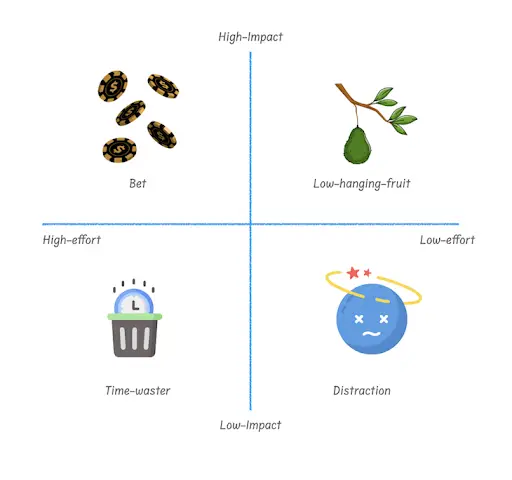Do you know what drains energy and kills motivation? Prioritization. Take a moment to reflect on these questions:
- How long does it take you to decide on prioritization?
- What are the results of your prioritization efforts?
- Can you focus on one task at a time, or do you need to multitask and stretch yourself thin?
- How engaging are prioritization sessions for you?
I’ve experienced this problem from various perspectives: customer, software engineer, product manager, head of product, and chief product officer. One thing has remained constant: prioritization is a drag on energy and enthusiasm.
In this guide, we’ll show you how to simplify and streamline prioritization using the impact effort matrix.
Table of contents
The problem with complex prioritization techniques
As someone who prefers simplicity, I find complex methods challenging. There are countless prioritization techniques out there, and I’ve tried most of them, including RICE, ICE, and buy-a-feature.
To me, these frameworks seem overly technical and often overlook the heart of prioritization, which is collaboration. More often than not, I found that our discussions went in circles and the outcomes were mediocre at best. Team members would endlessly mull over a decision with only a few fully accepting it. As a result, we kept revisiting the same topics.
Ultimately, prioritization should enable teams to focus on what matters most. Teams will struggle with high context-switching costs until they agree on priorities.
Poor prioritization can demotivate teams and lower morale. However, you can transform this process with a simple tool: the impact effort matrix.
What is the impact effort matrix?
The impact effort matrix is a simple, direct tool that accelerates decision-making. The following image represents my version of this matrix:
The axes: Impact vs. effort
When I first encountered the impact effort matrix, I wondered how it could be used for prioritization. I was accustomed to using multiple parameters, and now it was reduced to two. How could this work?
As Leonardo Da Vinci said, “Simplicity is the ultimate sophistication.”
The impact matrix comprises two axes:
- Impact — What is the potential impact of the initiative? The greater the impact, the more promising it becomes
- Effort — How much time and resources are required to achieve the potential impact?
You don’t need solid evidence for either aspect. The primary goal when using this matrix is collaboration, which we’ll discuss shortly.
The quadrants
The beauty of the impact effort matrix lies in its ability to help you categorize opportunities and clarify where to invest your time.
There are different names and definitions for the quadrants, but what truly matters is creating a shared understanding among team members.
My version of the impact effort matrix includes the following quadrants:
- Time-wasters — Tasks that demand high effort but yield minimal impact. Avoid these items whenever possible, though some may be necessary (for example, due to regulations)
- Distractions — These are nice-to-have tasks that are relatively easy to implement but create distractions rather than value. Exercise caution; just because you can do something doesn’t mean you should
- Bets — Some initiatives are promising but require significant effort. Sometimes you need to take gambles, but it’s crucial to know what to expect from them
- Low-hanging fruit — These are tasks that are highly impactful and relatively easy to implement. Prioritize them because they create value quickly with minimal effort
How to use the impact effort matrix (6 steps)
Now that you understand the mechanics of the impact effort matrix, you might wonder how it can handle a backlog with hundreds of items.
The following steps will help you get the most out of the impact effort matrix:
- Define a goal — Start by setting a target, which could be an objective, a product goal, or anything that helps you evaluate how each item contributes to achieving your goal. Without delving into specifics, it’s essential to have an overarching aim
- Group items — When dealing with a massive backlog, group the items into manageable sets. Ideally, you should have no more than 15 items. In agile terms, these groups would be your epics (big-picture user stories)
- Discard groups — Focus on your goal and evaluate each epic based on its relevance to the target. Discard any items unrelated to the goal; they will only distract you
- Place them into the matrix — Engage in a team discussion using a compare-and-contrast approach. Collaboration and alignment are crucial here. Place an item in the matrix, compare its effort and impact with the others, and continue this process until you reach a consensus. Generally, this takes about an hour
- Agree on a sequence — With the items clustered, determine their order of execution. Remember that not everything can be a priority; decide what comes first and what follows
- Assign responsibility — Once the sequence is clear, allocate the tasks across your teams. If you have only one team, work through the list from top to bottom
Prioritization doesn’t have to be a nightmare. The steps outlined above help you embrace simplicity to make the process more manageable.
Final thoughts
Beware of commitment escalation traps. No matter how well you prioritize, executing the work is a separate challenge. The more effort you invest in a task, the more cautious you should be because you might make mistakes.
Instead of diving in headfirst, begin with quick experiments to gauge what works and what doesn’t. Continuously iterate and scale your efforts gradually. Remember, prioritization is just the starting point; it doesn’t mean you must implement everything you’ve prioritized.
Keep an eye on the evidence and adjust your prioritization based on new findings. Effective prioritization enables teams to concentrate on what truly matters, allowing them to uncover hidden opportunities and create impactful products.
Featured image source: IconScout
The post Impact effort matrix: Prioritization made simple appeared first on LogRocket Blog.
from LogRocket Blog https://ift.tt/RCijuNS
Gain $200 in a week
via Read more
Source link







Leave a Reply